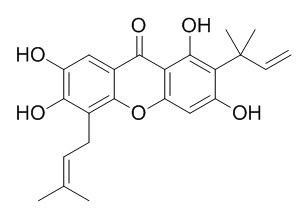Cudraxanthone L
Cudraxanthone L shows the significant hepatoprotective effect on nitrofurantoin-induced cytotoxicity in human liver-derived Hep G2 cells.
Inquire / Order:
manager@chemfaces.com
Technical Inquiries:
service@chemfaces.com
Tel:
+86-27-84237783
Fax:
+86-27-84254680
Address:
1 Building, No. 83, CheCheng Rd., Wuhan Economic and Technological Development Zone, Wuhan, Hubei 430056, PRC
Providing storage is as stated on the product vial and the vial is kept tightly sealed, the product can be stored for up to
24 months(2-8C).
Wherever possible, you should prepare and use solutions on the same day. However, if you need to make up stock solutions in advance, we recommend that you store the solution as aliquots in tightly sealed vials at -20C. Generally, these will be useable for up to two weeks. Before use, and prior to opening the vial we recommend that you allow your product to equilibrate to room temperature for at least 1 hour.
Need more advice on solubility, usage and handling? Please email to: service@chemfaces.com
The packaging of the product may have turned upside down during transportation, resulting in the natural compounds adhering to the neck or cap of the vial. take the vial out of its packaging and gently shake to let the compounds fall to the bottom of the vial. for liquid products, centrifuge at 200-500 RPM to gather the liquid at the bottom of the vial. try to avoid loss or contamination during handling.
Separations2023, 10(2), 131.
Acta horticulturae2017, 1158:257-268
Sci Rep.2024, 14(1):26330.
Food Sci Nutr.2023, 00:1-10.
J Med Food.2016, 19(12):1155-1165
The Journal of Korean Medicine2023, 44(4):26-40.
Heliyon.2024, 10(7):e28364.
Eur J Pharmacol.2024, 981:176883.
University of Manitoba2023, 37433.
Molecules.2019, 24(4):E744
Related and Featured Products
J Nat Prod. 2007 Jul;70(7):1207-9.
Prenylated xanthones from the root bark of Cudrania tricuspidata.[Pubmed:
17608532]
METHODS AND RESULTS:
Four new prenylated xanthones, cudratricusxanthones J-M (1-4), were isolated from the CH2Cl2-soluble extract of the root bark of Cudrania tricuspidata, along with four known prenylated xanthones, isocudraxanthone K (5), cudraxanthone C (6), cudratricusxanthone A (7), and Cudraxanthone L (8), and three known prenylated flavonoids, cudraflavone A (9), cudraflavanone A (10), and cudraflavone B (11).
CONCLUSIONS:
The structures of compounds 1-4 were elucidated using spectroscopic methods. Cudratricusxanthone A (7), cudraflavanone A (10), and cudraflavone B (11) showed moderate inhibitory effects on mouse brain monoamine oxidase (MAO) with IC50 values of 88.3, 89.7, and 80.0 microM, respectively.
Arch Pharm Res. 2005 Jan;28(1):44-8.
Hepatoprotective constituents of Cudrania tricuspidata.[Pubmed:
15742807]
METHODS AND RESULTS:
Phytochemical investigation of the MeOH extract of the root barks of Cudrania tricuspidata Bureau (Moraceae), as guided by hepatoprotective activity in vitro, furnished four isoprenylated xanthones, cudratricusxanthone A (1), Cudraxanthone L (2), cudratricusxanthone E (3), and macluraxanthone B (4).
CONCLUSIONS:
All of these compounds showed the significant hepatoprotective effect on tacrine-induced cytotoxicity in human liver-derived Hep G2 cells. Compounds 1, 2, and 4 also exhibited the significant hepatoprotective effect on nitrofurantoin-induced cytotoxicity in human liver-derived Hep G2 cells.
Cytotoxic xanthones from Cudrania tricuspidata.
Cytotoxic xanthones from Cudrania tricuspidata.[Pubmed:
15787460]
METHODS AND RESULTS:
The new isoprenylated tetrahydroxyxanthone, 2,3,6,8-tetrahydroxy-1-(3-methylbut-2-enyl)-5-(2-methylbut-3-en-2-yl)-9H-xanthen-9-one (1), was isolated from the root bark of Cudrania tricuspidata together with macluraxanthone B (2) and Cudraxanthone L (3), which were fully characterized by NMR spectroscopic and X-ray crystallographic analyses.



